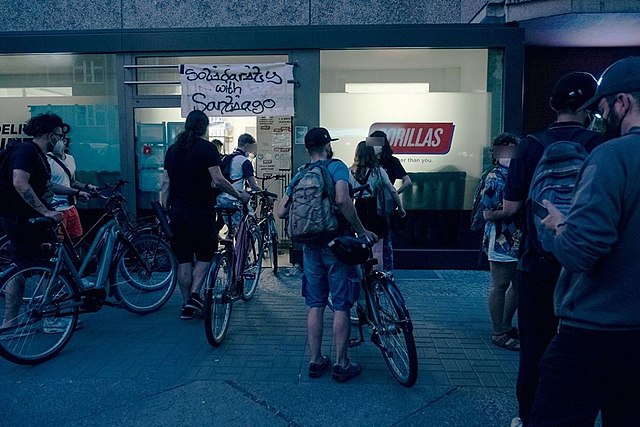How did you start and what was your position at Gorillas?
Camilo: I started working in Gorillas in October 2020. I was working as a rider in different warehouses and districts.
The working conditions changed quite a bit as Gorillas grew very quickly, expanding the number of warehouses and delivery orders.
At first it was an easy job. You had enough time to sit down, read a book, and have a cup of coffee. Then we had the first winter of the pandemic. The weather became worse and there were a lot of people ordering. All those little breaks disappeared. That became a heavy load to carry—both literally and metaphorically.
What was your experience carrying this heavy load?
Camilo: It was very bad. By law, you’re not supposed to carry more than 10 kilograms on your back, but this is never actually measured in the warehouses. People would order a bunch of beers or water and it would be terrible.
Having back pain after a shift was probably the most common reason why people wouldn’t go to work. People were on sick leave because of back pain, and this can be chronic in the long run. But at the very beginning we all assumed it to be part of the job. We weren’t aware of this limit of 10 kilograms.
We also have to bear in mind that most Gorillas workers are immigrants. They are either students or people on a working holiday visa. They don’t know much about the legal framework here. Also, the working conditions are still better than what people have in their home countries.
It was pretty bad in the warehouse I was working at—the heating was broken and they never fixed it. This was the winter when there was a snowstorm in Berlin. You would get back to the warehouse all wet, and all they gave us was hairdryers to try to warm our hands. I caught tonsillitis and was sick for about two months.
There was little protection against COVID. The warehouses were packed. It was not a safe place to work.
But I didn’t have an option, as I needed the work. Like most people who worked there, I was put on a six-month probation period, meaning we could get fired for no reason. This made it scary to complain, especially for people who are really dependent on this job.
Can you tell me more about the working conditions in the warehouse? You mentioned working during the blizzard.
Camilo: That was something else. Gorillas now provide equipment for you, like bikes, helmets sometimes and winter gear. This has been improving over the last few months. But at the very beginning it wasn’t like that. They always promised to give people jackets, but many never received them so we had to share. During the pandemic this was not so hygienic.
The bikes were not owned by Gorillas but rented from another company. Sometimes they would have weird noises or the handle would be loose; the brakes wouldn’t work properly. I didn’t have any accidents, but a lot of people did because they were sitting on the bike and the seat fell off or the brakes didn’t work, so they crashed against a car.
Again, people felt like they could not complain or individually refuse to work because they could get fired. They had to expose themselves to these very dangerous conditions.
We also have to remember that the Gorillas business model is providing groceries in under 10 minutes. Even though they tell you to be careful when you drive, you have to get there in under 10 minutes. You are pressured to be quick. You often disregarded your own safety.
You were also part of the Gorillas Workers Collective. When did the GWC get started?
Camilo: Before the blizzard came, somebody had written an open letter to Gorillas Management. A colleague of mine read out the letter at the end of a shift and said: “Who wants to sign it?” The letter was asking the company to listen to workers and try to find a way to fix the problems. I signed, hoping to find people that I could talk to about this.
Then the blizzard came. People from two warehouses refused to work. Basically, they organized a spontaneous strike.
This forced the company to acknowledge that working conditions were precarious and to close down operations for the day. It gave a signal to the workers that if we organize, we can do something about it.
On that day, all other delivery companies had decided not to continue operations but Gorillas said, “We’re so cool. We’ll still do it,” which is the attitude of Gorillas’ marketing.
I reached out to this person who had presented the letter and said that I’d like to contribute to whatever’s happening because we should do something. I was invited to an online meeting. I think that was the first meeting of the collective.
There were maybe eight people, and a member of FAU, who gave us a general framework of possibilities. He suggested a Betriebsrat, which is something that many of us had never heard about.
We tried to have meetings every one or two weeks. We didn’t have a clear idea of what to do. We just knew that we needed some kind of critical mass in the company, because if we wanted to create a workers’ council, we needed support from people.
There was a lot of undercover work like putting stickers up in the bathrooms with a QR code to join a Telegram group. That was fun. We also tried to organize social gatherings with riders outside work. That was difficult because of COVID, as people had not yet been vaccinated.
Then we made a logo and printed a bunch of stickers.
In July 2021, the Gorillas CEO said he wouldn’t fire anyone over the strikes. But then he did it anyway. What did you make of this?
Camilo: None of us actually believed him when he said that, but it increased the media attention about what was happening. But it’s easier for them to let people go and maybe ruin their image than to have a strike.
Once they fired the staff from entire warehouses. That was a strong hit to our collective, because a lot of new people were starting to join the collective. But then they all got fired, though some managed to get reinstated through court cases.
We were hoping to have some kind of rotation. Without rotation, you end up creating hierarchies and bureaucrats who don’t really represent the workers.
People got tired after that, others got another job. It was very distressing dealing with court cases as most of us are immigrants. Just the idea of having to go to court is scary. Everything is in German and it’s too much. That was the company’s strategy—to dissolve what we’re doing by intimidating us.
What can you tell me about these firings even being legal?
Camilo: A lot of firings were not legal and some of them fell in a grey area.
In the early days, they tried to fire somebody from the collective. But they gave him a termination letter without the proper signature. We already had some legal support, who then spotted that mistake and contested the firing.
This person got reinstated. This is when we created the workers’ council. Before that, we were thinking, “Maybe we should wait until we have a critical mass.” But by starting that process, we could provide protection against being sacked.
You only need three people to call for an assembly, which elects an electoral council, which in turn organizes the elections for the workers council. The three people who call for the election get immediate protection. By law, they cannot be fired.
That created a trench for us to to fight from. We didn’t have to be completely undercover because we had these three faces that could speak on behalf of the group. That was a very important moment.
When we formed the Electoral Council, it was about nine people who then also got protection. Some of those people got unlawfully fired because they had been seen on the strikes.
There’s a lot of things that Gorillas does that are not legal and they just get away with it because contesting it takes a long time. There is a court hearing where you wait for months. In that process, people get tired.
You’re always dealing with an algorithm or with an app or an email address. You don’t have somebody that you can directly talk with. You can go to HR and ask what’s going on, but there’s no human that you can talk with. This makes the whole process much more frustrating.
You said that German laws say it’s legal to strike as long as you go through established unions. And unions can, in retrospect, take the strikes under their wings. Does the Gorillas Workers Collective consider joining an established union?
Camilo: I would say no as far as I know, because of the kind of relationship that we had with the unions when I was there. The NGG union was helpful when it came to organizing the assembly where we elected the Electoral Council. Then we were transferred to Ver.di because that was the sector that we fell under. And Ver.di were always trying to deter us from striking.
Old union structures have their own internal hierarchies which were useful 100 years ago. But for a lot of people in the collective, they don’t apply to how the industry works today with temporary work.
People are just going to be in Gorillas for three, six months, a year at the most, and then leave the country. They’re not really interested in getting affiliated with a union and paying for membership.
When we were starting, and some of us asked Ver.di for support, they were not interested. But when things became a little more public, they said they supported us. But the approach they took was so patronizing.
When Ver.di came knocking on our door, we already knew how to constitute a workers council because we had taken some workshops that had been facilitated through the FAU. But they came trying to teach us how to do it.
They invited us to a meeting to talk about how we can support each other. But for them, it was a meeting to educate us on how we should do things. They were telling us how the things we were doing were wrong and that striking was wrong.
Our reaction was, “Who are you people? Fuck you, we don’t need your help if you’re going to do it like this.” It felt to me that we were spending more energy trying to deal with them than any practical support we were actually getting from them.
So, I don’t see the collective getting affiliated with any union. And it seems like Ver.di didn’t like FAU and FAU didn’t like Ver.di, and they’re fighting each other. We didn’t want to take part in this. We have a struggle. If you want to support us, come support us. But we’re not going to be part of this partisanship.
Did you feel you’re kind of part of a bigger movement? Your strike and unionizing process was followed internationally.
Camilo: For sure. I had the chance to go to Brussels, because we were invited by a French Left MEP Leila Chaibi to meet organizers in the delivery sector around the world. All of a sudden I was sitting there in the European Parliament, talking to this super high authority.
I consider myself to be a newbie over there because the organizers there were older people and really knew what they were doing. I was just listening, really. But the political space that we created served as a place of resistance.
On the one hand, you had the workers’ struggles, on the other, there’s the struggle against racism and patriarchy. The FLINTA* population within the collective was very important. The collective is a site for articulating other struggles. I see the collective as a site for articulating other struggles, which itself is also a struggle on its own.
You don’t work with Gorillas anymore. But you’re writing your master’s thesis about it. Can you tell me more about this?
Camilo: I’m using the Gorillas Workers Collective as a case study. I’m particularly interested in researching the role of care work in political organizations. How do we value the work that we do when we organize?
I mean care in a very broad way. It’s not just about who makes the food or takes care of children. It’s also how we develop skills to communicate with each other. How do we deal with emotions within our space?
It may have looked like we being quite successful at what we’re doing, but inside there was a lot of conflicts. This took away our energy from other things. The group experienced a lot of burnout and fractures.
Reproductive work, care work, checking in with each other, knowing how to solve conflicts were always put last. Productive work, like organizing a strike, was always fluid. It was seen as the most urgent thing. But in my opinion, it wasn’t.
If we can’t sit down with each other and maybe write about our convictions or the red line that unites us, we won’t be able to work together for a long time. We will not be able to make it sustainable.
I’m thinking about this idea of sustainable solidarity. It was really frustrating for me to spend 30-60 minutes together trying to write a manifesto. When we started doing this, people started dropping out. They didn’t come to the meetings and they would only come to “productive” meetings, like for the strikes or preparing interview.
I’m looking forward to what you’ll say on sustainable solidarity, care work and other struggles in your thesis.
Camilo: There’s still a long way to go, but luckily I do have a lot of auto-ethnographic experience that I can draw from. I’m also trying to do some synergy between my activism and academia.




